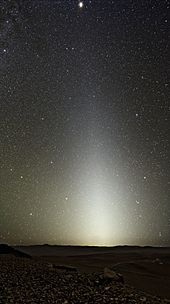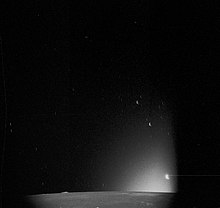
A comet is an icy, small Solar System body that warms and begins to release gases when passing close to the Sun, a process called outgassing. This produces an extended, gravitationally unbound atmosphere or coma surrounding the nucleus, and sometimes a tail of gas and dust gas blown out from the coma. These phenomena are due to the effects of solar radiation and the outstreaming solar wind plasma acting upon the nucleus of the comet. Comet nuclei range from a few hundred meters to tens of kilometers across and are composed of loose collections of ice, dust, and small rocky particles. The coma may be up to 15 times Earth's diameter, while the tail may stretch beyond one astronomical unit. If sufficiently close and bright, a comet may be seen from Earth without the aid of a telescope and can subtend an arc of up to 30° across the sky. Comets have been observed and recorded since ancient times by many cultures and religions.

Gegenschein or counterglow is a faintly bright spot in the night sky centered at the antisolar point. The backscatter of sunlight by interplanetary dust causes this optical phenomenon.

The Solar System is the gravitationally bound system of the Sun and the objects that orbit it. The largest of these objects are the eight planets, which in order from the Sun are four terrestrial planets ; two gas giants ; and two ice giants. The Solar System developed 4.6 billion years ago when a dense region of a molecular cloud collapsed, forming the Sun and a protoplanetary disc.

The asteroid belt is a torus-shaped region in the Solar System, centered on the Sun and roughly spanning the space between the orbits of the planets Jupiter and Mars. It contains a great many solid, irregularly shaped bodies called asteroids or minor planets. The identified objects are of many sizes, but much smaller than planets, and, on average, are about one million kilometers apart. This asteroid belt is also called the main asteroid belt or main belt to distinguish it from other asteroid populations in the Solar System.

A meteor shower is a celestial event in which a number of meteors are observed to radiate, or originate, from one point in the night sky. These meteors are caused by streams of cosmic debris called meteoroids entering Earth's atmosphere at extremely high speeds on parallel trajectories. Most meteors are smaller than a grain of sand, so almost all of them disintegrate and never hit the Earth's surface. Very intense or unusual meteor showers are known as meteor outbursts and meteor storms, which produce at least 1,000 meteors an hour, most notably from the Leonids. The Meteor Data Centre lists over 900 suspected meteor showers of which about 100 are well established. Several organizations point to viewing opportunities on the Internet. NASA maintains a daily map of active meteor showers.

The night sky is the nighttime appearance of celestial objects like stars, planets, and the Moon, which are visible in a clear sky between sunset and sunrise, when the Sun is below the horizon.

The interplanetary medium (IPM) or interplanetary space consists of the mass and energy which fills the Solar System, and through which all the larger Solar System bodies, such as planets, dwarf planets, asteroids, and comets, move. The IPM stops at the heliopause, outside of which the interstellar medium begins. Before 1950, interplanetary space was widely considered to either be an empty vacuum, or consisting of "aether".
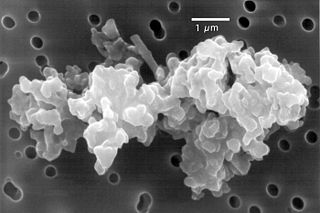
Cosmic dust – also called extraterrestrial dust, space dust, or star dust – is dust that occurs in outer space or has fallen onto Earth. Most cosmic dust particles measure between a few molecules and 0.1 mm (100 μm), such as micrometeoroids. Larger particles are called meteoroids. Cosmic dust can be further distinguished by its astronomical location: intergalactic dust, interstellar dust, interplanetary dust, and circumplanetary dust. There are several methods to obtain space dust measurement.
The interplanetary dust cloud, or zodiacal cloud, consists of cosmic dust that pervades the space between planets within planetary systems, such as the Solar System. This system of particles has been studied for many years in order to understand its nature, origin, and relationship to larger bodies. There are several methods to obtain space dust measurement.
Comet dust refers to cosmic dust that originates from a comet. Comet dust can provide clues to comets' origin. When the Earth passes through a comet dust trail, it can produce a meteor shower.

A small Solar System body (SSSB) is an object in the Solar System that is neither a planet, a dwarf planet, nor a natural satellite. The term was first defined in 2006 by the International Astronomical Union (IAU) as follows: "All other objects, except satellites, orbiting the Sun shall be referred to collectively as 'Small Solar System Bodies' ".

Exozodiacal dust is 1–100 micrometre-sized grains of amorphous carbon and silicate dust that fill the plane of extrasolar planetary systems. It is the exoplanetary analog of zodiacal dust, the 1–100 micrometre-sized dust grains observed in the solar system, especially interior to the asteroid belt. As with the zodiacal dust, these grains are probably produced by outgassing comets, as well as by collisions among bigger parent bodies like asteroids. Exozodiacal dust clouds are often components of debris disks that are detected around main-sequence stars through their excess infrared emission. Particularly hot exozodiacal disks are also commonly found near spectral type A-K stars. By convention, exozodiacal dust refers to the innermost and hottest part of these debris disks, within a few astronomical units of the star. How exozodiacal dust is so prevalent this close to stars is a subject of debate with several competing theories attempting to explain the phenomenon. The shapes of exozodiacal dust clouds can show the dynamical influence of extrasolar planets, and potentially indicate the presence of these planets. Because it is often located near a star's habitable zone, exozodiacal dust can be an important noise source for attempts to image terrestrial planets. Around 1 in 100 stars in the nearby solar systems shows a high content of warm dust that is around 1000 times greater than the average dust emission in the 8.5–12 μm range.

Retrograde motion in astronomy is, in general, orbital or rotational motion of an object in the direction opposite the rotation of its primary, that is, the central object. It may also describe other motions such as precession or nutation of an object's rotational axis. Prograde or direct motion is more normal motion in the same direction as the primary rotates. However, "retrograde" and "prograde" can also refer to an object other than the primary if so described. The direction of rotation is determined by an inertial frame of reference, such as distant fixed stars.
This glossary of astronomy is a list of definitions of terms and concepts relevant to astronomy and cosmology, their sub-disciplines, and related fields. Astronomy is concerned with the study of celestial objects and phenomena that originate outside the atmosphere of Earth. The field of astronomy features an extensive vocabulary and a significant amount of jargon.
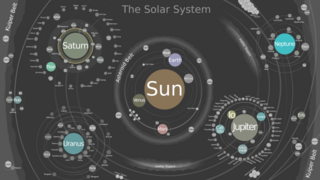
The following outline is provided as an overview of and topical guide to the Solar System:

Sergei Ivanovich Ipatov is a Soviet, Russian, and American scientist, laureate of the F. A. Bredikhin Prize in astronomy of the Russian Academy of Sciences, Doctor of Physical and Mathematical Sciences. Asteroid 14360 Ipatov was named in his honor.

Space dust measurement refers to the study of small particles of extraterrestrial material, known as micrometeoroids or interplanetary dust particles (IDPs), that are present in the Solar System. These particles are typically of micrometer to sub-millimeter size and are composed of a variety of materials including silicates, metals, and carbon compounds. The study of space dust is important as it provides insight into the composition and evolution of the Solar System, as well as the potential hazards posed by these particles to spacecraft and other space-borne assets. The measurement of space dust requires the use of advanced scientific techniques such as secondary ion mass spectrometry (SIMS), optical and atomic force microscopy (AFM), and laser-induced breakdown spectroscopy (LIBS) to accurately characterize the physical and chemical properties of these particles.

The Helios 1 and 2 spacecraft each carried two dust instruments to characterize the Zodiacal dust cloud inside the Earth’s orbit down to spacecraft positions 0.3 AU from the sun. The Zodiacal light instrument measured the brightness of light scattered by interplanetary dust along the line of sight. The in situ Micrometeoroid analyzer recorded impacts of meteoroids onto the sensitive detector surface and characterized their composition. The instruments delivered radial profiles of their measured data. Comet or meteoroid streams, and even interstellar dust were identified in the data.
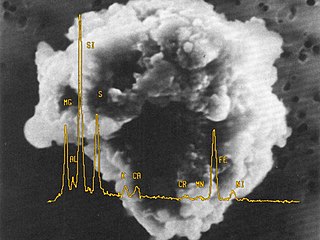
Dust astronomy is a subfield of astronomy that uses the information contained in individual cosmic dust particles ranging from their dynamical state to its isotopic, elemental, molecular, and mineralogical composition in order to obtain information on the astronomical objects occurring in outer space. Dust astronomy overlaps with the fields of Planetary science, Cosmochemistry, and Astrobiology.




